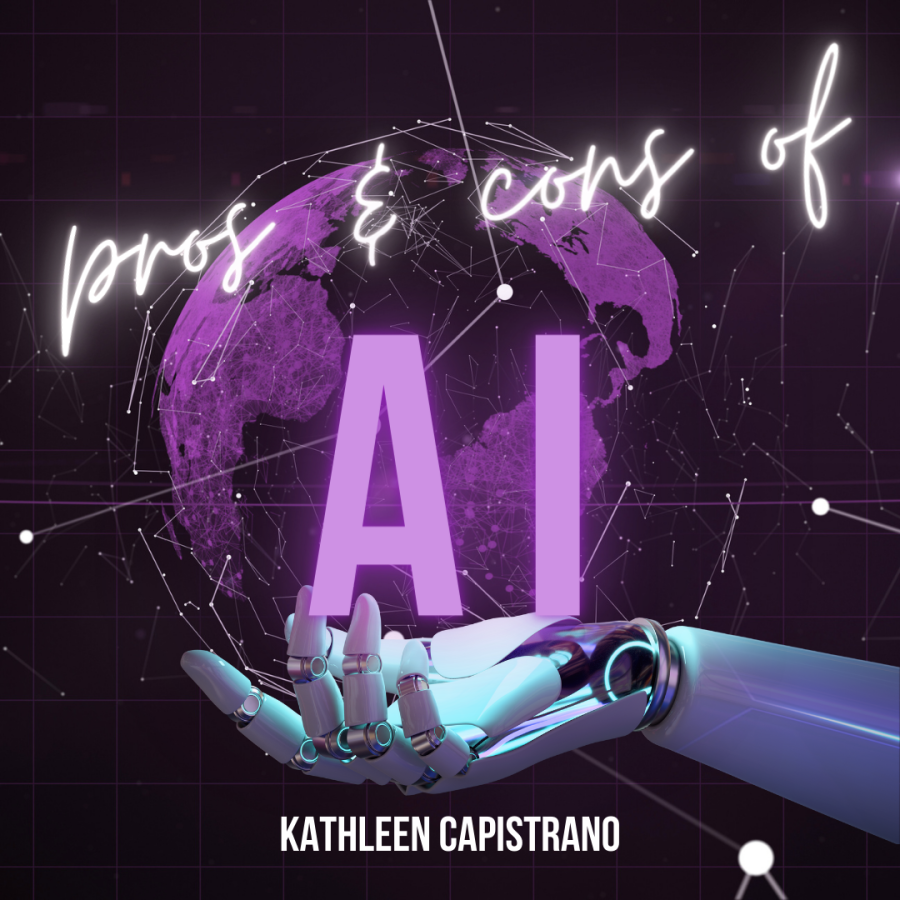The pros and cons of AI
Efficiency over ethicality?
June 1, 2023
Recently, there has been a large increase in the general usage and application of AI (artificial intelligence), either through voice assistants, FaceID, or even something as common as simple Google searches.
According to Precedence Research, the artificial intelligence market has a 38.1% CAGR (compound annual growth rate), compared to an average of 15 to 20%. Because CAGR shows the estimated average rate of growth for an investment, there is no denying that the AI market has a ton of potential in the future.
AI allows big corporations and companies to automate and complete simple processes faster, which allows employees to work on more complex work. AI systems also work more efficiently and accurately with data spreadsheets, which reduces the chances of simple human error.
With our current technology, AI also has the ability to tailor and personalize systems to a person’s tastes, like the TikTok “for you” page. This makes it easier to find items, clothing, or pictures more suited to your tastes, which admittedly, can save a bunch of time.
However, these benefits also bring about concerns regarding how ethical AI programs really are.
Recently, there have been numerous complaints on social media, stating that “AI art” is not real art, and that it is borderline plagiarism. This is because AI art generators use a database of millions of images and use them to compile artwork with different styles and techniques. The pictures in question can be anything, from stock images, to hand-drawn artwork. Additionally, AI has also showcased the ability to finish works in progress.
“In a way, it does count as ‘real art,’ but I think the ethics behind the method it was created with is the most questionable,” said junior Emily Shanks. “You can definitely argue that it’s the same as being drawn by a human artist, but at the same time I understand why artists are angry with this kind of technology.”
Not only this, but many are worried about deepfake AI, which manipulates media in order to mimic someone. This type of technology can especially be dangerous when the person using it has malicious intentions. They can make it look like an influential person is saying or doing something they wouldn’t.
Alongside appearance mimicry, AI has also managed to mimic voices, a popular example being an AI cover of Ariana Grande singing Dua Lipa’s song. According to the New York Times, because AI has the ability to converse with more human-like behaviors, experts worry that people will fall for misinformation more easily, which could pose a huge problem.
Another recently popularized AI program is ChatGPT, which has raised many alarming concerns. This is because the program has access to a giant database of information, which if leaked, could be used for malicious purposes.
Because ChatGPT is trained by compilations of human writing throughout history, the AI tends to pick up biases and even discriminatory behavior.
And as stated in Forbes’ ChatGPT article, “Systems like ChatGPT have produced outputs that are nonsensical, factually incorrect—even sexist, racist, or otherwise offensive.”
“With the release of Snapchat AI, I’ve seen some examples of AI bots saying some bizarre things online, and it’s a little weird,” said Shanks.
Also, according to NPR.org, schools, in particular, are keeping an eye on this chatbot, noticing an increase in student plagiarism. Technology like this can make teachers’ jobs harder and even dissuade students from doing their own work.
“It doesn’t uphold the honor code, and it’s basically just an even lazier method of cheating using AI,” said junior Brenna McDevitt.
Most of the time AI can be efficient and consistent, but even then, it is still susceptible to mistakes. Of course, AI is constantly learning and improving, but it is important to keep in mind that relying on AI may not be the best choice. Even with the recent AI advancements, it is unlikely AI will be replacing human labor anytime soon.

